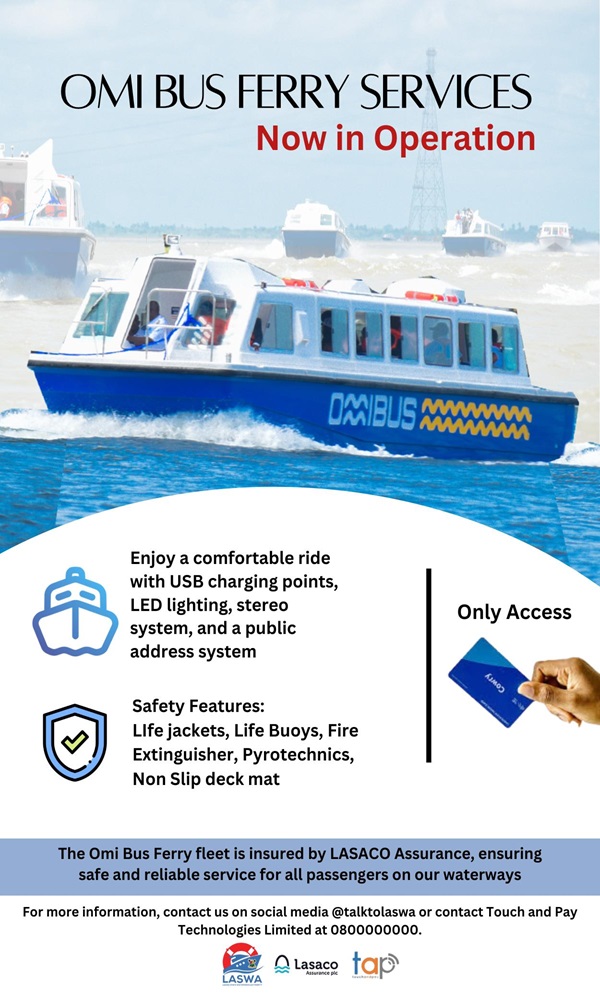- Govt to deploy 1000 Electric vehicles by 2025
By Demilade Adeniyi
The Lagos State Government has said the second metro rail system, the Red Line will begin commercial operation in second quarter 2024.
This is just as it said over one million passengers have used the Blue rail, the first phase which connects Marina to Mile 2 and had commenced commercial operation on September 4.
Disclosing this at a Press conference marking the 20th anniversary of the establishment of the Lagos Metropolitan Area Transport Authority (LAMATA), the Managing Director Engr. (Mrs) Abimbola Akinajo, said this is to further demonstrate the commitment of the Babajide Sanwo-Olu administration to Transportation and Traffic Management pillar of the THEMES+ agenda and to explore alternative fuel for urban mobility and improve our air quality.
While work on the second phase of the Blue light rail is ongoing with completion expected before 2026, work on all the five stations on the red line on the other hand, will be completed before the end of December, and test run on the red line will start in the first quarter 2024, ahead of full commercial operation.
Mrs Akinajo also disclosed that no fewer than 1000 electric buses (EBs) would be deployed to the roads in the next 24 months.
Already, the government in collaboration with Oando Clean Energy Limited (OCEL), has deployed two e-vehicles (EV) to test proof the concept and there are plans to increase this to 50 buses during the pilot phase, adding that; “the plan is to increase the fleet to over 1000 buses in the next two years.”
She disclosed that the state is also piloting the use of Clean Natural Gas (CNG) as auto fuel for its vehicles, adding that already, 10 CNG buses are being used on selected BRT corridors to test their adaptability to public transport.
She said these fits perfectly into LAMATA’s Strategic Transportation Masterplan where emission will be reduced and achieve the state’s vision to achieve net zero emission by 2050, through the deployment of eco-friendly rolling stock like CNG, Biofuel and electric buses.
On the Lagos Urban Train Projects (LUTP), Mrs Akinajo said LAMATA has delivered on the Blue Line rail, a fully electric rail system, adding that work on civil works on the second rail project – the Red Line, will be completed before the end of the year, with test running proposed to commence by Quarter 1, 2024, while commercial services will begin by Quarter 2, 2024.
Mrs Akinajo said the last 20 years has seen LAMATA recording several milestones, adding that its vision for the next 20 years, is the delivery of a more robust public intermodal transport system.
“As we begin another 20 years, our vision is to see a Lagos where all transport modes are integrated, and people do not need to put their vehicles on the road get to where they want to go, a Lagos where emission will be reduced, she said.”
She said LAMATA has played pivotal roles in developing integrated multimodal transport system for Lagos State, beginning with the implementation of the $200 million credit from the World Bank for the implementation of the Lagos Urban Transport Project known as the LUTP 1, a project which gave birth to the first Bus Rapid Transit (BRT) system, described by the World Bank as the first successful BRT in sub-Saharan Africa. LAMATA has also implemented LUTP 2, jointly funded by the World Bank and the Agence Française de Développement (AFD).
She said LAMATA came up with the first Strategic Transport Master Plan (STMP) in 2009 for the Lagos Metropolitan Area, with a more elaborate one developed in 2014 to cover the entire State and four neighbouring local government areas of Ogun State.
LAMATA also rehabilitated 630km of federal, state and local government of roads considered as germane to ease the daily commuting of Lagosians.
Some of these roads include Akin Adesola, Idejo, and others in Victoria Island, Oba Sekumade Road, Ikorodu, Ayo Alabi Road, which connects Ajayi Road to Ogba in the Ikeja Local Government area of the State, Alaba Road, Ojo, WEMPCO Road, Ikeja, Ijegun Road in Alimosho and many others.
LAMATA was also able to solve the flood problem on WEMPCO Road with an underground drainage with outfall into Omole Gorge.
The LAMATA chief said in the last 20 years, the agency built and operationalized the 13kmOshodi-Abule-Egba and 34km Ikorodu-CMS BRT Corridor,and implemented two of the six rail lines –Blue and Red, and with the support of parent Ministry, Lagos State Ministry of Transportation facilitated the development of the Lagos Non-Motorised Transport (NMT) policy, which the government approved in 2019.
“Under the Bus Reform Initiative (BRI), the Lagos State Government procured 920 environmentally friendly buses which we manage on behalf of Government. As part of the BRT, we have constructed Modern Bus Terminals at Ikeja, Ojota, Ifako-Ijaiye, Yaba, Oyingbo, MMIA/Ewu, Ajah, Abule Egba etc.)
“We have implemented an Intelligent Transport System (ITS), and deployed Automated Fare Collection System with the use of Cowry Card. There are over 4 million cards in use.”
The LAMATA Chief said the agency is currently implementing the phase 1 of the AFD and IFC funded Lagos State Strategic Transport Master Plan (LSTMPP1), which involves the construction of two Interchanges, eight Quality Bus Corridors, and implementation of various studies on the LSTMP Projects.
Mrs Akinajo thanked the all past governors in the state, beginning from Asiwaju Bola Ahmed Tinubu, (now Nigeria’s President), Mr Babatunde Raji Fashola, Mr Akinwunmi Ambode and the current governor, Mr Babajide Sanwo-Olu for thinking outside the box in giving to Lagosians an agency that is making transportation seamless in the state. She equally acknowledged all her predecessors in office, from the pioneer Managing Director, Dr Dayo Mobereola and Engr Abiodun Dabiri, as well as all past and current workers and all other stakeholders for their roles in the growth of LAMATA.
























